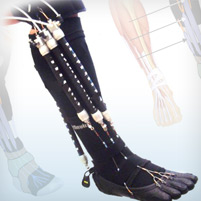Robotic Orthotic


Yong-Lae Park
A soft, wearable device that mimics the muscles, tendons and ligaments of the lower leg could help people with ankle-foot disorders, said Yong-Lae Park, an assistant professor of robotics at Carnegie Mellon University.
While there has been extensive research on hard exoskeleton-style robots to aid movement, many of the designs come from traditional robot design that take advantages of mechanical linkages and joints. These devices improve function but, because they are often rigid, limit body movement.
So Park took a different approach.
"I first wanted to look into how our ankles work with our biological muscles before starting mechanical designs, and realized that our ankles move in much more complicated ways than typical robotic ankles," Park said.
The result was a simplified version of an ankle that was wearable but still allowed for natural motion. The device is made of soft materials, combined with pneumatic artificial muscles, lightweight sensors and advanced control software.
Park worked with collaborators at Harvard University on the development of the device. Some of the members of the group are now at the University of Southern California, MIT and BioSensics.
"We hope to test the device with patients at some point," Park said. "However, we still need to go through multiple design iterations to make sure of the efficacy and the safety of the device, and it will take time."
In the future, the work could aid people with neuromuscular disorders of the foot and ankle associated with cerebral palsy, amyotrophic lateral sclerosis, multiple sclerosis or stroke, which can affect a person's ability to walk.
Park said the same approach could be used to create rehabilitative devices for other joints of the body or even to create soft exoskeletons to increase the strength of the wearer.
He conducted the work as a post-doctoral researcher at Harvard's Wyss Institute for Biologically Inspired Engineering and was supported by the Wyss Institute and the National Science Foundation.
Related Links: Read press release | Robotics Institute | Bioinspiration & Biomimetics Journal Article
